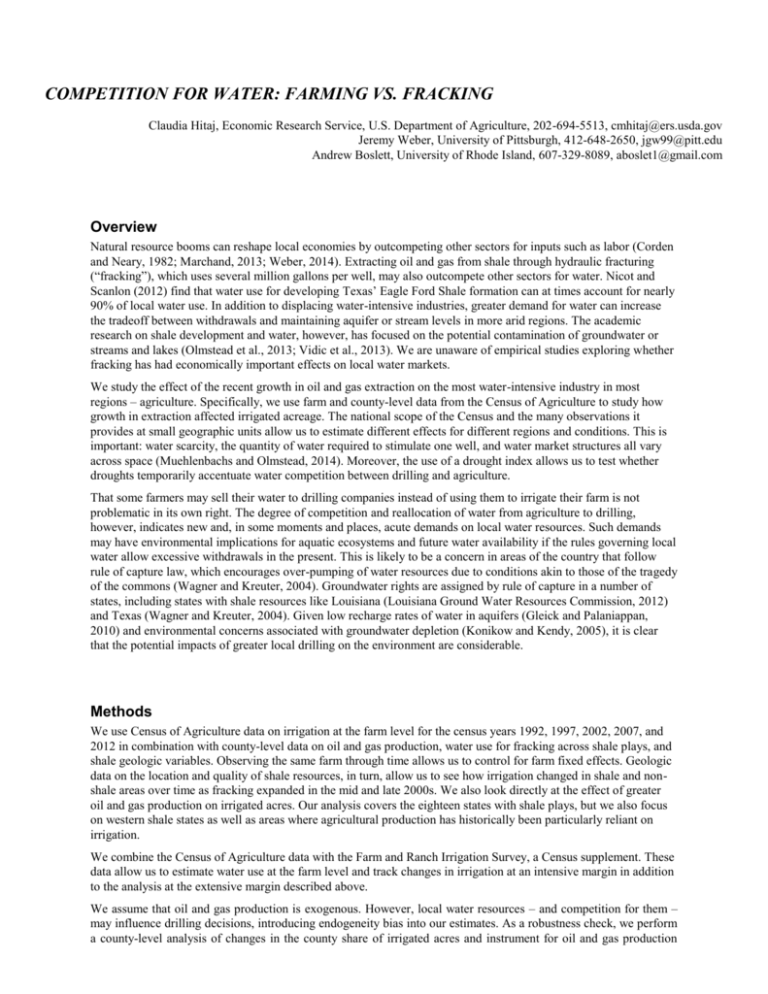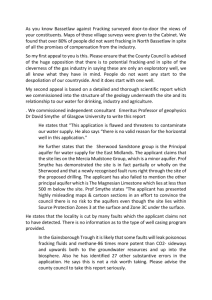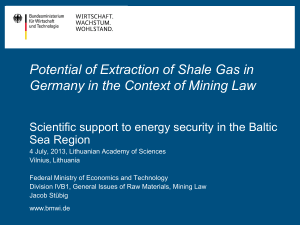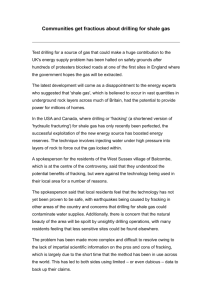View Extended Abstract - United States Association for Energy
advertisement

COMPETITION FOR WATER: FARMING VS. FRACKING Claudia Hitaj, Economic Research Service, U.S. Department of Agriculture, 202-694-5513, cmhitaj@ers.usda.gov Jeremy Weber, University of Pittsburgh, 412-648-2650, jgw99@pitt.edu Andrew Boslett, University of Rhode Island, 607-329-8089, aboslet1@gmail.com Overview Natural resource booms can reshape local economies by outcompeting other sectors for inputs such as labor (Corden and Neary, 1982; Marchand, 2013; Weber, 2014). Extracting oil and gas from shale through hydraulic fracturing (“fracking”), which uses several million gallons per well, may also outcompete other sectors for water. Nicot and Scanlon (2012) find that water use for developing Texas’ Eagle Ford Shale formation can at times account for nearly 90% of local water use. In addition to displacing water-intensive industries, greater demand for water can increase the tradeoff between withdrawals and maintaining aquifer or stream levels in more arid regions. The academic research on shale development and water, however, has focused on the potential contamination of groundwater or streams and lakes (Olmstead et al., 2013; Vidic et al., 2013). We are unaware of empirical studies exploring whether fracking has had economically important effects on local water markets. We study the effect of the recent growth in oil and gas extraction on the most water-intensive industry in most regions – agriculture. Specifically, we use farm and county-level data from the Census of Agriculture to study how growth in extraction affected irrigated acreage. The national scope of the Census and the many observations it provides at small geographic units allow us to estimate different effects for different regions and conditions. This is important: water scarcity, the quantity of water required to stimulate one well, and water market structures all vary across space (Muehlenbachs and Olmstead, 2014). Moreover, the use of a drought index allows us to test whether droughts temporarily accentuate water competition between drilling and agriculture. That some farmers may sell their water to drilling companies instead of using them to irrigate their farm is not problematic in its own right. The degree of competition and reallocation of water from agriculture to drilling, however, indicates new and, in some moments and places, acute demands on local water resources. Such demands may have environmental implications for aquatic ecosystems and future water availability if the rules governing local water allow excessive withdrawals in the present. This is likely to be a concern in areas of the country that follow rule of capture law, which encourages over-pumping of water resources due to conditions akin to those of the tragedy of the commons (Wagner and Kreuter, 2004). Groundwater rights are assigned by rule of capture in a number of states, including states with shale resources like Louisiana (Louisiana Ground Water Resources Commission, 2012) and Texas (Wagner and Kreuter, 2004). Given low recharge rates of water in aquifers (Gleick and Palaniappan, 2010) and environmental concerns associated with groundwater depletion (Konikow and Kendy, 2005), it is clear that the potential impacts of greater local drilling on the environment are considerable. Methods We use Census of Agriculture data on irrigation at the farm level for the census years 1992, 1997, 2002, 2007, and 2012 in combination with county-level data on oil and gas production, water use for fracking across shale plays, and shale geologic variables. Observing the same farm through time allows us to control for farm fixed effects. Geologic data on the location and quality of shale resources, in turn, allow us to see how irrigation changed in shale and nonshale areas over time as fracking expanded in the mid and late 2000s. We also look directly at the effect of greater oil and gas production on irrigated acres. Our analysis covers the eighteen states with shale plays, but we also focus on western shale states as well as areas where agricultural production has historically been particularly reliant on irrigation. We combine the Census of Agriculture data with the Farm and Ranch Irrigation Survey, a Census supplement. These data allow us to estimate water use at the farm level and track changes in irrigation at an intensive margin in addition to the analysis at the extensive margin described above. We assume that oil and gas production is exogenous. However, local water resources – and competition for them – may influence drilling decisions, introducing endogeneity bias into our estimates. As a robustness check, we perform a county-level analysis of changes in the county share of irrigated acres and instrument for oil and gas production using geologic variables, such as shale depth and thickness, which are uncorrelated with surface irrigation levels. We also distinguish between an agriculture-wide shale development effect and an irrigation-specific effect. For example, labor demand from shale development might raise wages and therefore costs for irrigated and non-irrigated agriculture, causing both to decline. We therefore estimate the effect of development on non-irrigated acreage. Results Our findings suggest that fracking has a negative impact on irrigated acres. In addition, irrigation in agriculture declines over time with increased fracking activity in shale formations. This effect is most pronounced in areas that have historically high irrigation levels. We compare the impact of shale development on irrigated and non-irrigated agriculture and find that the decline in irrigation does not simply reflect the effect of shale development on agriculture overall but a more pronounced effect on irrigated agriculture through competition for water. Our study also analyzes how the impact of shale development on agricultural production and the environment varies regionally depending on the water market regimes and level of aridness. Conclusions Increased competition for water resources is not an issue in a well-functioning water market but becomes problematic only when water is priced incorrectly. In this case, the new demand for water from the energy industry acts as an additional stressor in a system of unsustainable water use. Conflicting statements from the energy and agricultural industry on the severity of the issue mean this is a topic worth researching and of interest to USAEE conference attendees. Note The analysis and conconclusions expressed are those of the authors and should not be attributed to the Economic Research Service of the U.S. Department of Agriculture. References Corden, W.M., Neary, P.J. 1982. Booming sector and de-industrialization in a small open economy. Economic Journal 92, 825-848. Gleick, P.H., Palaniappan, M., 2010. Peak water limits to freshwater withdrawal and use. Proceedings of the National Academy of Sciences 107(25): 11155-11162. Konikow, L.F., Kendy, E., 2005. Groundwater depletion: A global problem. Hydrogeology Journal 13(1): 317-320. Louisiana Ground Water Resources Commission, 2012. Managing Louisiana’s Groundwater Resources. An interim report to the Louisiana Legislature. Marchand, J., 2012. “Local Labor Market Impacts of Energy Boom-Bust-Boom in Western Canada.” Journal of Urban Economics 71: 165-174. Muehlenbachs, L. and S. Olmstead, 2014, “Hydraulic Fracturing and Water Resources” Choices 29(4). Nicot, J., Scanlon, B.R., 2012. Water use for shale-gas production in Texas, U.S.. Environmental Science & Technology 46 (6): 3580-3586. Olmstead, S.M., Muehlenbachs, L.A., Shih, J.S., Chu, Z., and A. Krupnick, 2013. Shale gas development impacts on surface water quality in Pennsylvania. Proceedings of the National Academy of Sciences. Vidic, R.D., S.L. Brantley, J.M. Vandenbossche, D. Yoxtheimer, and J.D. Abad, 2013. Impact of Shale Gas Development on Regional Water Quality. Science 340(6134). Wagner, M.W., Kreuter, U.P. 2004. Groundwater supply in Texas: Private land considerations in a rule-of-capture state. Society & Natural Resources: An International Journal 17(4): 349-357. Weber, J.G. 2014. A decade of natural gas development: The makings of a resource curse? Resource and Energy Economics 37: 168-183.








